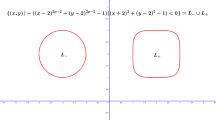Abstract
A classical theorem by Chebyshev says how to obtain the minimum and maximum values of a symmetric multiaffine function of n variables with a prescribed sum. We show that, given two functions in an Extended Chebyshev space good for design, a similar result can be stated for the minimum and maximum values of the blossom of the first function with a prescribed value for the blossom of the second one. We give a simple geometric condition on the control polygon of the planar parametric curve defined by the pair of functions ensuring the uniqueness of the solution to the corresponding optimization problem. This provides us with a fundamental blossoming inequality associated with each Extended Chebyshev space good for design. This inequality proves to be a very powerful tool to derive many classical or new interesting inequalities. For instance, applied to Müntz spaces and to rational Müntz spaces, it provides us with new inequalities involving Schur functions which generalize the classical MacLaurin’s and Newton’s inequalities. This work definitely demonstrates that, via blossoms, CAGD techniques can have important implications in other mathematical domains, e.g., combinatorics.




Similar content being viewed by others
References
R. Ait-Haddou, L. Biard, and M. A. Slawinski, Minimizing blossoms under symmetric linear constraints, Comput. Aided Geom. Design 19 (2002), 421–431.
R. Ait-Haddou, S. Yusuke, and T. Nomura, Chebyshev blossoming in Müntz spaces: Toward shaping with Young diagrams, J. Comput. Appl. Math. 247 (2013), 172-208.
H. Alzer, The inequality of Ky Fan and related results, Acta Appl. Math. 38 (1995), 305–354.
P. S. Bullen, Handbook of Means and their Inequalities, in: Mathematics and its Applications, 560, Kluwer Academic Publishers Group, Dordrecht, 2003, Revised from the 1988 original [P. S. Bullen, D. S. Mitrinović and P. M. Vasić, Means and their Inequalities, Reidel, Dordrecht; MR0947142]
P. Chebyshev, Demonstration élémentaire d’une proposition générale de la théorie des probabilités, J. Reine Angew. Math. 33 (1846), 259–267.
A. Cuttler, C. Greene, and M. Skandera. Inequalities for symmetric means, European J. Combinatorics 32 (2011), 745–761.
V. Gorin and G. Panova, Asymptotics of symmetric polynomials with applications to statistical mechanics and representation theory, Ann. Probab. 43 (2015), 3052–3132.
Harish-Chandra, Differential operators on a semisimple Lie algebra, Amer. J. Math. 79 (1957), 87–120.
G. H. Hardy, J. E. Littlewood and G. Pólya, Inequalities, Cambridge University Press, Cambridge, 1934.
W. Hoeffding, On the distribution of the number of successes in independent trials, Ann. Math. Statist. 27 (1956), 713–721.
A. Horwitz, Means, generalized divided differences, and intersections of osculating hyperplanes, J. Math. Anal. Appl. 200 (1996), 126–148.
C. Itzykson and J. B. Zuber, The planar approximation. II, J. Math. Phys. 21 (1980), 411–421.
J. Keilson, A theorem on optimum allocation for a class of symmetric multilinear return functions, J. Math. Anal. Appl. 15 (1966), 269–272 .
I. G. Macdonald, Symmetric Functions and Hall Polynomials, Oxford University Press, second edition, 1995.
M.-L. Mazure, Vandermonde type determinants and blossoming, Adv. Comput. Math. 8 (1998), 291–315.
M.-L. Mazure and P.-J. Laurent, Nested sequences of Chebyshev spaces, Math. Mod. Num. Anal. 32 (1998), 773–788.
M.-L. Mazure, Blossoming: a geometrical approach, Constr. Approx. 15 (1999), 33–68.
M.-L. Mazure, Chebyshev splines beyond total positivity, Adv. Comput. Math. 14 (2001), 129–156.
M.-L. Mazure, Chebyshev spaces and Bernstein bases, Constr. Approx. 22 (2005), 347–363.
M.-L. Mazure, Ready-to-blossom bases in Chebyshev spaces, in Topics in Multivariate Approximation and Interpolation, K. Jetter et al (eds.), Elsevier, Amsterdam, 2006, pp. 109–148.
M.-L. Mazure, Bernstein-type operators in Chebyshev spaces, Numer. Algorithms 52 (2009), 93–128.
M.-L. Mazure, Finding all systems of weight functions associated with a given Extended Chebyshev space, J. Approx. Theory 163 (2011), 363–376.
M.-L. Mazure, How to build all Chebyshevian spline spaces good for Geometric Design, Numer. Math. 119 (2011), 517–556.
M.-L. Mazure, Extended Chebyshev spaces in rationality, BIT Num. Math. 53 (2013), 1013–1045.
A. O. Pittenger, The logarithmic mean in n variables, Amer. Math. Monthly 92 (1985), 99–104.
H. Pottmann, The geometry of Tchebycheffian splines, Comput. Aided Geom. Design 10 (1993), 181–210.
L. Ramshaw, Blossoms are polar forms, Comput. Aided Geom. Design 6 (1989), 323–358.
B. Sagan, The Symmetric Group: Representations, Combinatorial Algorithms, and Symmetric Functions, Springer-Verlag, New York, 2001.
H.-P. Seidel, New algorithms and techniques for computing with geometrically continuous spline curves of arbitrary degree, Math. Model. Numer. Anal. 26 (1992), 149–176.
S. Sra, On inequalities for normalized Schur functions, Europ. Combin. 51 (2016), 492–494.
K. B. Stolarsky, Generalizations of the logarithmic mean, Math. Mag. 48 Z (1975), 87–92.
Author information
Authors and Affiliations
Corresponding author
Additional information
Communicated by Nira Dyn.
The research of Rachid Ait-Haddou was supported by KAUST.
Rights and permissions
About this article
Cite this article
Ait-Haddou, R., Mazure, ML. The Fundamental Blossoming Inequality in Chebyshev Spaces—I: Applications to Schur Functions. Found Comput Math 18, 135–158 (2018). https://doi.org/10.1007/s10208-016-9334-8
Received:
Revised:
Accepted:
Published:
Issue Date:
DOI: https://doi.org/10.1007/s10208-016-9334-8
Keywords
- Extended Chebyshev spaces
- Chebyshevian blossoming
- MacLaurin’s inequalities
- Newton’s inequalities
- Müntz spaces
- Normalized Schur functions



